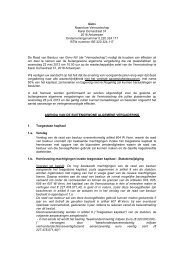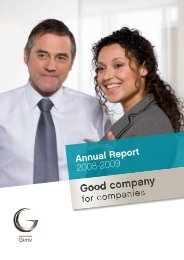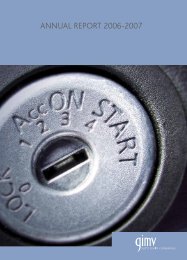ANNUAL REPORT 2007 | 2008 - Gimv
ANNUAL REPORT 2007 | 2008 - Gimv
ANNUAL REPORT 2007 | 2008 - Gimv
You also want an ePaper? Increase the reach of your titles
YUMPU automatically turns print PDFs into web optimized ePapers that Google loves.
5.22 Revenue recognition<br />
Revenue is recognized whenever it is probable that the economic<br />
benefi ts will fl ow to the <strong>Gimv</strong> group and the revenue can<br />
be reliably measured.<br />
With respect to sale of goods, revenue is recognized at the<br />
time that the signifi cant risks and rewards of ownership of the<br />
goods have passed to the buyer. Sales are recognized when<br />
persuasive evidence of an agreement can be presented, delivery<br />
has occurred, the remuneration is fi xed and determinable, and<br />
collectibility is probable.<br />
For work in progress the percentage of completion method is<br />
used, where the outcome of the contract can be assessed with<br />
reasonable certainty.<br />
For the rendering of services, revenue is recognized by reference<br />
to the stage of completion. In the case of government<br />
grants, revenue is recognized as income pari passu with the<br />
depreciation of the underlying fi xed assets.<br />
5.23 Employee benefi ts<br />
Post employment benefi ts comprise pensions, life insurance<br />
and medical care.<br />
Retirement benefi ts under defi ned contribution and defi ned<br />
benefi t plans are provided through separate funds or insurance<br />
plans.<br />
- defi ned contribution plans:<br />
Contributions to defi ned contribution pension plans are recognized<br />
as an expense in the income statement as incurred.<br />
- defi ned benefi t plans:<br />
For defi ned benefi t plans, the amount recognized in the<br />
balance sheet is determined as the present value of the defi<br />
ned benefi t obligation less any past service costs not yet<br />
recognized and the fair value of any plan assets. Where the<br />
calculation results in a net surplus the recognized asset is<br />
limited to the total of all cumulative unrecognized past service<br />
costs and the present value of any refunds from or reductions<br />
in future contributions to the plan.<br />
The recognition of actuarial gains and losses is determined<br />
separately for each defi ned benefi t plan. Actuarial gains and<br />
losses are fully recognized in the income statement in the period<br />
in which they are established.<br />
116 | <strong>Gimv</strong> Annual Report <strong>2007</strong>-<strong>2008</strong> | Statutory consolidation<br />
5.24 Share-based payment transactions<br />
As part of the remuneration system and in order to involve employees<br />
more closely in the respective investment portfolios,<br />
options and/or shares are offered to members of staff in the<br />
co-investment companies which have been set up on a business<br />
unit basis. The cost of the options/shares allocated in this<br />
way is calculated based on the fair value of the share options<br />
at the date of allocation. Together with an identical increase in<br />
equity, this amount is taken into the income statement over the<br />
vesting period, ending on the date on which the employees in<br />
question are fully entitled to the allocation.<br />
5.25 Financial liabilities<br />
Interest-bearing loans and borrowings are initially valued at cost<br />
less transaction-related costs. After initial recognition, interestbearing<br />
loans and borrowings are subsequently measured at<br />
amortized cost using the effective interest method. In calculating<br />
the amortized cost, account is taken of any issue costs, and<br />
any redemption discount or premium.<br />
5.26 Dividends<br />
Dividends proposed by the Board of Directors are not recorded<br />
in the fi nancial statements until they have been approved by the<br />
shareholders at the annual General Meeting.<br />
5.27 Earnings per share<br />
The Group calculates both basic and diluted earnings per share<br />
in accordance with IAS 33. Basic earnings per share is computed<br />
using the weighted average number of shares outstanding<br />
during the period. Diluted earnings per share is computed using<br />
the average number of shares outstanding during the period<br />
plus the dilutive effect of warrants and stock options outstanding<br />
during the period.





